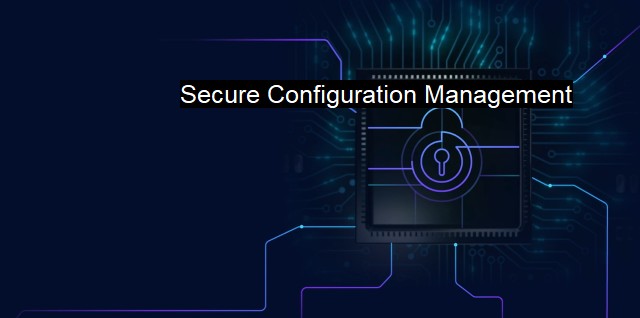What is Secure Configuration Management?
Understanding Secure Configuration Management in Cybersecurity and Antivirus: Tools and Best Practices for Mitigating Cyberthreats
Secure configuration management (SCM) is a critical system security component often used in the larger context of cybersecurity and antivirus. Sometimes also called secure configuration or secure settings management, it refers to the process of maintaining the security of a system or network by regulating and managing its configurations. It’s a cybersecurity process based on best practices that ensures a network or system's security state remains unmodified and is recoverable in the event of a security breach.Configuration management includes procedures that track system configuration changes to prevent, detect, and correct security lapses. Various configuration states in a system can invite vulnerabilities or potential threats. Thus, the role of secure configuration management is to assess systems continually and ensure they are fixed, hardened, and updated to guard against possible risks.
Most organizations utilize heterogeneous technology environments comprised of various operating systems, databases, network equipment, and applications. Each of these environments and systems come with their own unique configuration, increasing organizational complexity and risk. Cybercriminals continually seek these unfavorable or weak system configurations for easy access and exploitation to either steal data or launch more offensive attacks. Hence, organizations have to actively oversee and regulate each piece of technology—an activity facilitated by secure configuration management.
Secure configuration management relies on clearly defined baseline settings. These are configurations that meet exceptional standards of security, customized to an organization's specific needs. Security statutes like the Federal Information Security Management Act (FISMA) have set minimum standards for baseline settings.
Baselines may comprise mandatory system settings for components like firewalls, routers, web services, databases, encryption modules, and other system applications. They include stay-highly-secure best practices configurations that align with the overall corporate security strategy while complying with regulatory requirements.
Several tools allow for centralized secure configuration management, including System Center Configuration Manager (SCCM), which is useful for large-scale businesses. These tools will periodically evaluate the configuration settings against the optimal security standard, report discrepancies, and attempt to auto-correct the issue or alert security administrators. They can also provide a way to advance organizations' automation efforts, reducing their response time to these secure configuration vulnerabilities.
In the context of antivirus software, secure configuration management goes beyond detecting and removing malicious software. Although it's instrumental in safeguarding sensitive data from junk files and malware, both local and web-borne, it further hardens system configurations, ensuring antivirus software remains up-to-date while maintaining stringent baseline settings.
One shouldn't underrate the trifling aspects of secure configurations, such as universal default usernames and passwords, unnecessary software, hardened file permissions, and service configurations. These can significantly improve an organization's security posture with comparatively simple enhancements.
Keeping pace with evolving technology and security threats while frugally managing resources is challenging, but being compliant and maintaining secure configurations requires periodic, perhaps constant, attention and revisions.
Secure configuration management is an ongoing process that should be incorporated within the management lifecycle of every environment. This should ideally begin when an environment is created – not to fix a problem discovered later on. Leading security firms and experts consistently advocate incorporating this from the onset and implementing it as a part of routine operational procedures. Enterprises should inculcate it into their initial environment planning and design phases and continually evaluate and revise it as threats and systems change.
It's imperative to stress that secure configuration management isn't simply about technology—it's about orchestrating a far-sighted, repeatable process, and leveraging technology to ensure an organization's systems maintain the strongest possible defense posture. Thus, secure configuration management is a key facet of a robust cybersecurity approach, minimizing the attack surface, protecting against cyber threats, and helping ensure longevity in an ever-evolving technological landscape.

Secure Configuration Management FAQs
What is secure configuration management?
Secure configuration management refers to the process of managing and maintaining the security settings and configurations of software and hardware systems to minimize cybersecurity risks. It involves ensuring that all devices, applications, and systems are configured securely and in compliance with industry standards and best practices.Why is secure configuration management important?
Secure configuration management is crucial in preventing cyber attacks and maintaining the integrity of a system. Attackers often exploit vulnerabilities in poorly configured systems or applications to gain unauthorized access, steal data or introduce malware. By implementing secure configuration management practices, an organization can reduce the risks of cyber threats and maintain a strong security posture.What are some common secure configuration management practices?
Some common secure configuration management practices include regularly updating software and firmware, implementing access controls and proper authentication mechanisms, monitoring and logging system activities, and enforcing security policies and standards. Conducting periodic vulnerability scans and penetration testing can also help identify and address security weaknesses.What tools can be used for secure configuration management?
There are several tools and technologies available for secure configuration management, including security information and event management (SIEM) systems, network access control (NAC) solutions, and endpoint security software. Organizations can also use configuration management tools to automate the task of configuring and deploying software and hardware systems securely.| | A | | | B | | | C | | | D | | | E | | | F | | | G | | | H | | | I | | | J | | | K | | | L | | | M | |
| | N | | | O | | | P | | | Q | | | R | | | S | | | T | | | U | | | V | | | W | | | X | | | Y | | | Z | |
| | 1 | | | 2 | | | 3 | | | 4 | | | 7 | | | 8 | | |||||||